|
|

According to a recent news item that I came across on the net, researchers at the Liverpool John Moores University in UK found that meditation can actually help develop better brain power. In this study, the Buddhist technique of “mindfulness meditation” was used. On further Google search on meditation research, I found this extensive 472-page report, dated June 2007, produced by the Agency for Healthcare Research and Quality, U.S. Department of Health and Human Services. I have just glanced through the report and it seems to provide great details on studies conducted world-wide using a variety of meditation systems (including mantra, Buddhist, yoga, TaiChi etc.). At the end of the report there is a table listing world-wide meditation research activities and the major results found. It is a very impressive report and worth going through.
Continue reading »
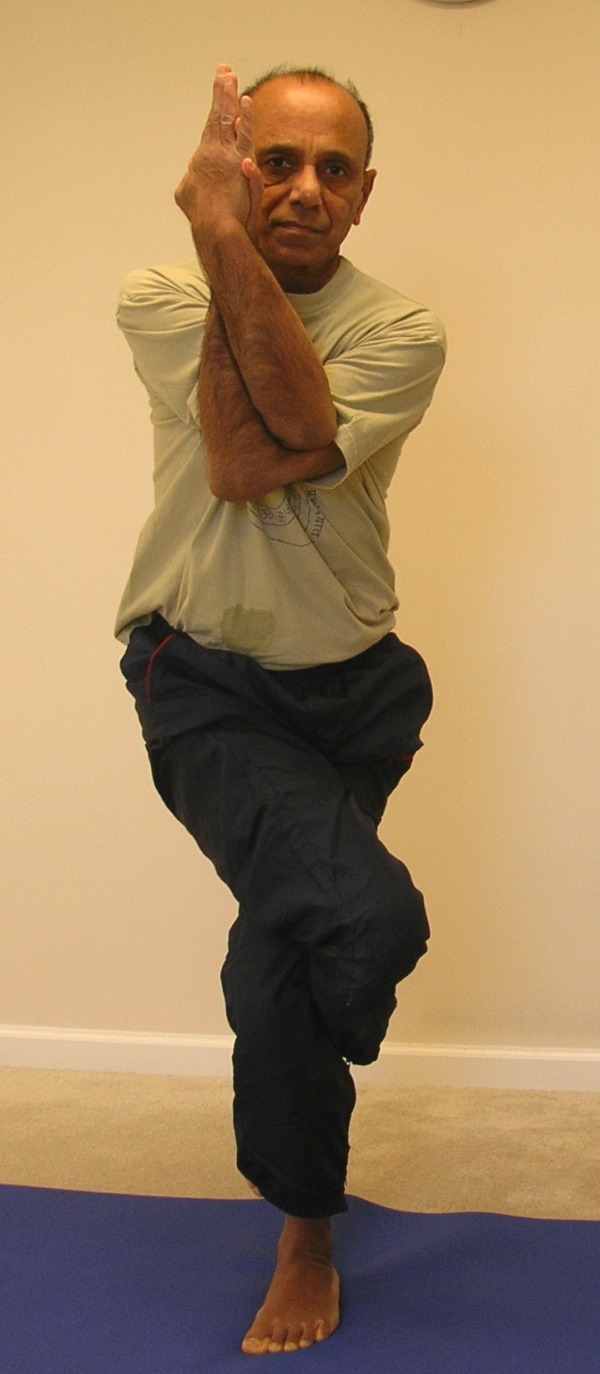
Garudasana (गरà¥à¤¡à¤¾à¤¸à¤¨) is so called because in the final pose it resembles the shape of an eagle, the hands representing the beak of the eagle. In Indian mythology, Garuda was the vehicle that carried Lord Vishnu through the celestial realms.
Step-by-Step
(click on the blue arrow for audio instructions)
- Start in the standing position with feet about hip-width apart.
Continue reading »
With this post, we will begin discussion of some of the balancing poses that are commonly practiced. We will start with the Tree Pose (Vrikshasana) (वृकà¥à¤·à¤¾à¤¸à¤¨) which is one of the most commonly practiced one-leg balancing poses. Here are some of the benefits that are common to all one-leg balancing poses.
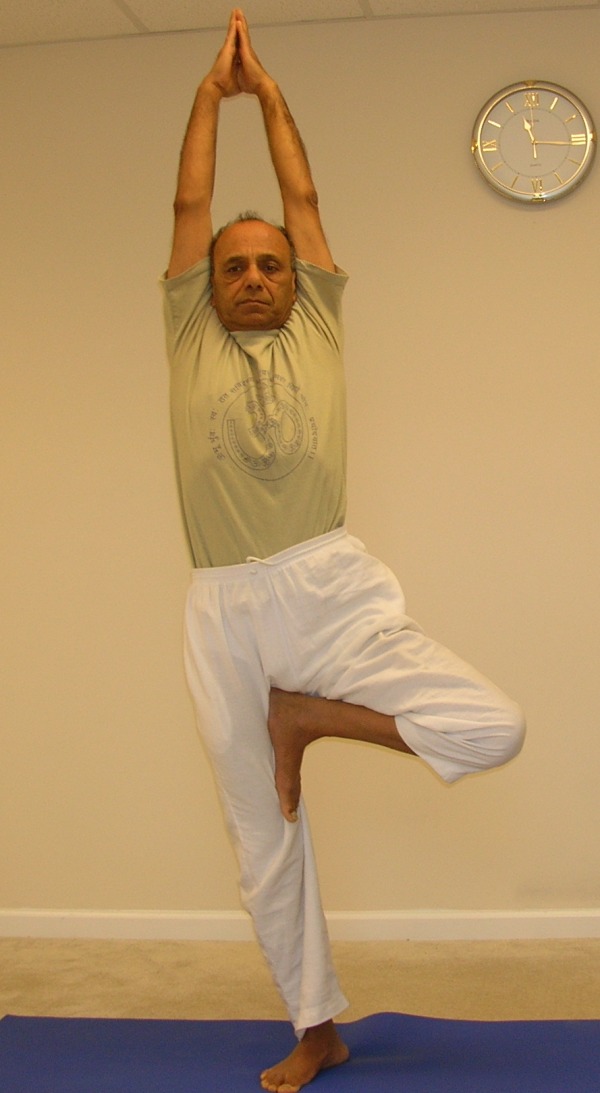
- Develop better coordination and harmony between different parts of the body
- Develop a sense of calm, mental stability and patience
- Remove stress and nervousness and bring about a state of mental equanimity
- Since one of the legs is doing the work of two legs in supporting the weight of the body, this supporting leg gets strengthened.
- They help develop not just physical balance, but also a deep sense of mental focus and concentration
The Tree Pose (Vrikshasana) is a relatively simple pose to practice and yet provides all the benefits of the one-leg balancing poses.
Step-by-Step
(click on the blue arrow for audio instructions)
- From the standing pose, lift the right foot up, shifting all the weight into the left leg. Turn the right knee all the way to the right resting the sole of the foot against the left thigh.
Continue reading »
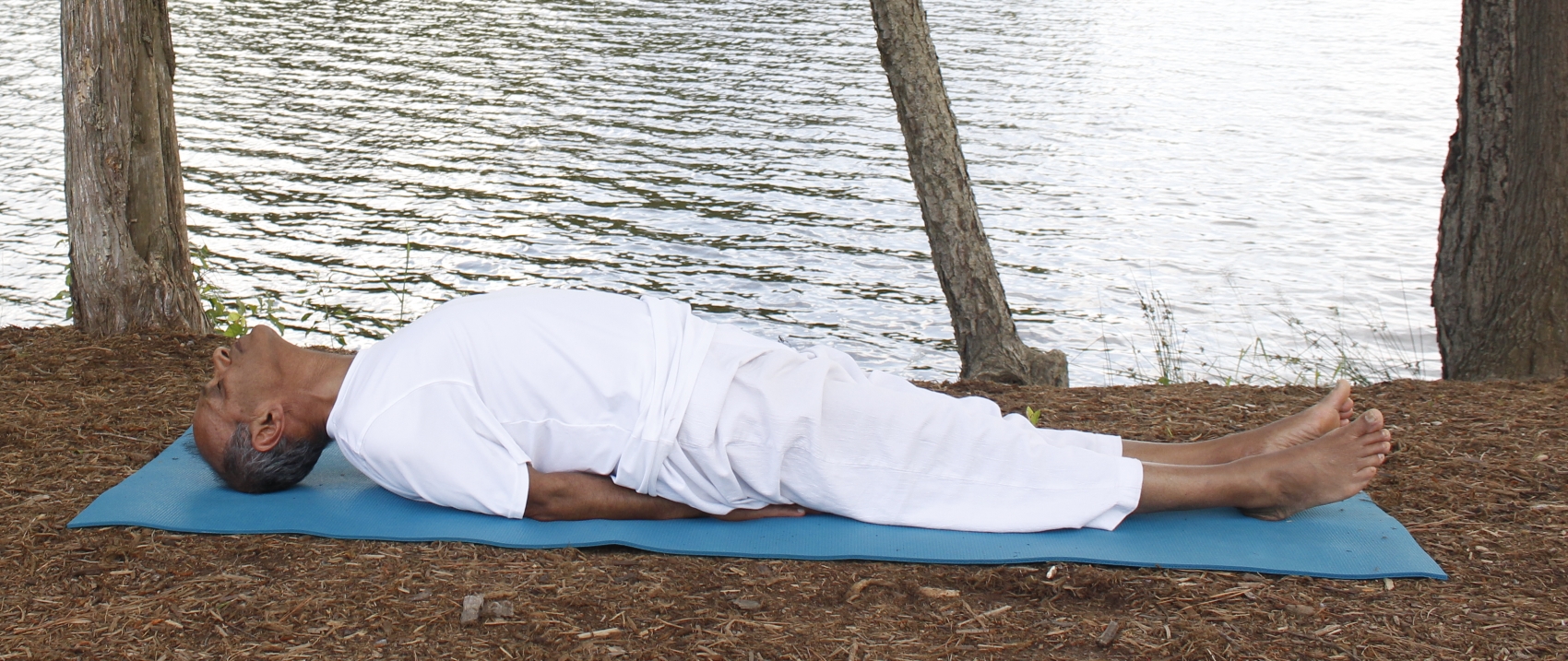
Matsyasana (मत्स्यासन)) or the Fish Pose is an excellent back bending pose. It is usually practiced as a counter pose for a forward-bending pose or the Shoulder Stand (Sarvanagasana). However, the pose has excellent benefits and can be practiced alone as well. In Sanskrit, the word "matsya" means fish. It is believed that one can float like a fish in water in this pose.
Step-by-Step
(click on the play button for audio instructions)
- Start in the Shavasana relaxation pose on the back.
Continue reading »
This is a continuation of the discussion of the simple stretches that can help relieve back pain.
Step-by-Step Instructions
Downward Facing Dog (Adhomukha-shvanasana)
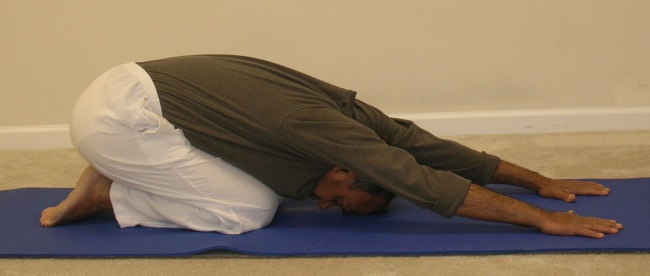
- Start in the child pose with the arms stretched out in front
- Inhale in place. With the next exhalation, curl the toes under, pressing down with the toes, lift the buttocks up coming up into the downward-facing dog position. In this position, make an effort to press the heels to the ground while keeping the tailbone lifted up.
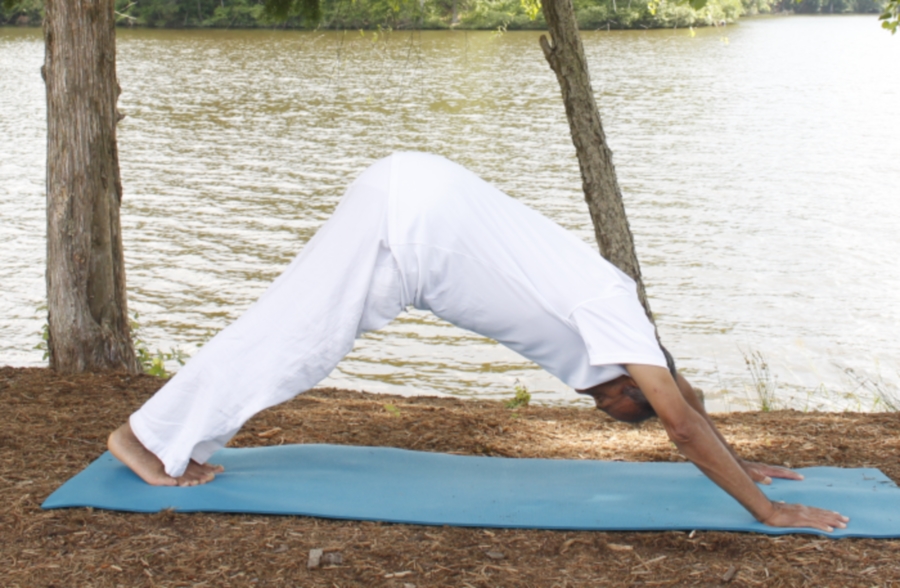
- While inhaling go back to the extended child pose
- Repeat steps 2 and 3 for three more breaths
- Next time when you come up into the downward-facing dog, stay in the pose for five deep breaths. Every time you inhale, try to lift the tailbone up, and every time you exhale, try to press the heels down.
- Finally, lower the buttocks on the heels and rest in child pose
Half Camel Pose (Ushtrasana)

- From the child pose, come up into a kneeling position with the tops of the feet and shins on the ground, thighs vertical, and knees hip-width apart. If needed, fold a blanket under the knees for support.
- Place the hands on the waist with the thumbs joined together at the soft spot at the lower spine, just above the tailbone
- As you inhale, pressing against the back with the thumbs, tilt your head back as far as comfortable. Make sure that the thighs stay in the vertical position, only the spine is arched.
- As you exhale, come back up straight
- Repeat steps 3 and 4 for five more breaths, keeping the movement synchronized with the breath
- Finally rest in the child pose
Leg Lift (Supta Padangushthasana)
- Lie down on your back in shavasana
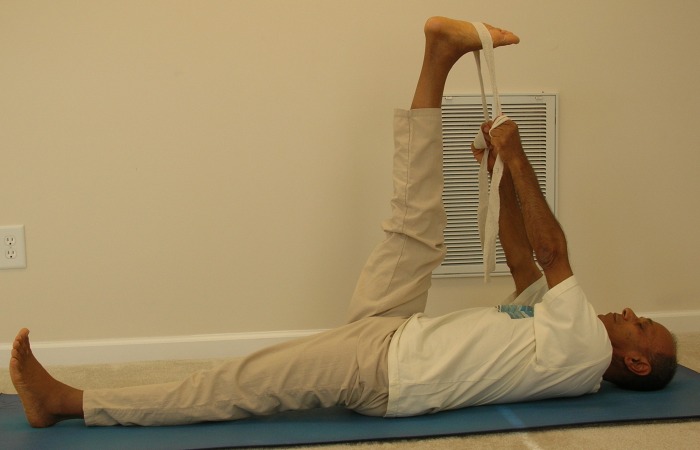
- Bring the feet together and put a strap around the right foot. As you inhale, using the strap, lift the right leg up and try to bring it to a vertical position. Try to keep the left thigh pressed to the floor.
- As you exhale, slowly bring the leg down to the floor
- Repeat steps 2 and 3 for two more breaths keeping the movement synchronized with breathing
- Next time you raise the leg up, hold it up there for four deep breaths. Then, while exhaling, slowly release the leg down.
- Repeat the above sequence with the other leg
Lying Spinal Twist (Reclining Supta Padangushthasana)
- Lie down on your back. Using a strap, while inhaling raise the right leg up to a vertical position. Try to keep the leg straight, without bending the knee.
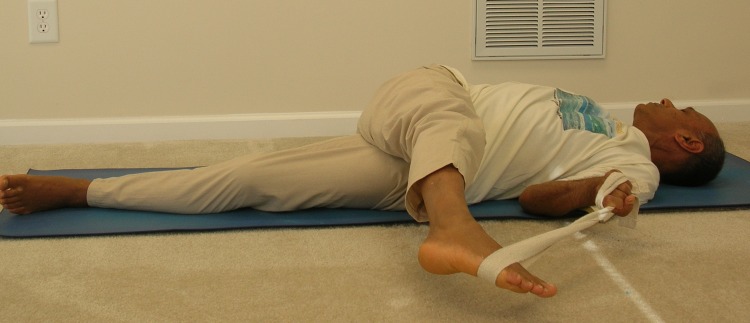
- Shift the strap to the left hand and stretch the right hand in line with the shoulders with the palm facing down. Look over the right shoulder.
- While exhaling, start lowering the right leg to your left side. Maintain a constant gentle pull on the leg with the strap while attempting to lower the right foot onto the floor. Try to keep the right shoulder firmly on the ground and try to keep the knee straight.
- Hold the final position for five deep breaths
- Very gently, while inhaling, raise the leg back up to a vertical position
- While exhaling, lower the leg down to the floor
- Repeat the above sequence with the other leg
Lying Spinal Twist – Variation
- Lie down on your back. Fold the right knee and place the sole of the right foot on top of the left knee.
- Stretch the arms into a T-shape (in line with the shoulders)
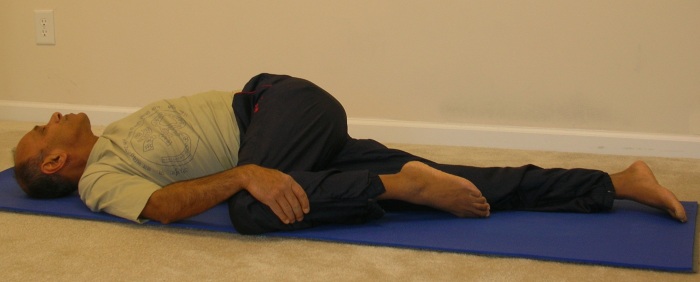
- Use the left hand to hold the raised right knee and start gently pulling the right knee to the floor on the left side. Make sure that the right shoulder stays firmly on the ground and keep looking over the right side. You may roll the right hip over the left while trying the bring the foot closer to the floor on the left side.
- Stay in the final position for five deep breaths
- While inhaling, slowly begin to come up and when the knee is vertical, stretch the leg straight.
- Repeat the above sequence on the other side
Wind-relieving Pose (Pavana-muktasana Sequence)
- Lie down on your back. Fold the right knee. Lifting the right foot up, hold the right shin with the two hands.
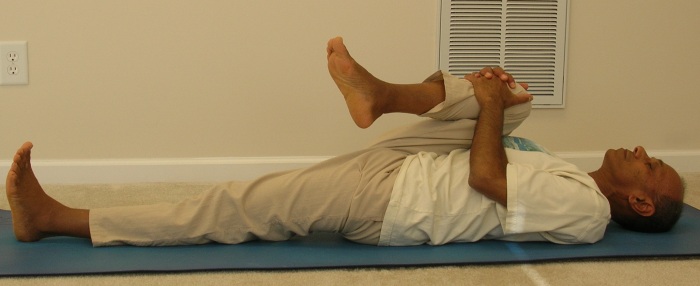
- While exhaling, gently begin to pull the knee while at the same time lifting the head up. In a conscious effort to round the spine, try to close the gap between the raised knee and the forehead
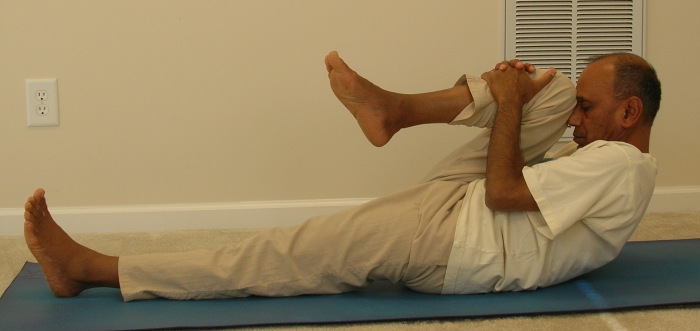
- Inhaling, lower the head down
- Repeat steps 2 and 3 for three more deep breaths
- Repeat the above sequence with the other leg
- Now fold both the knees. Lift the feet up and wrap the arms around the knees gently pulling the knees to the chest
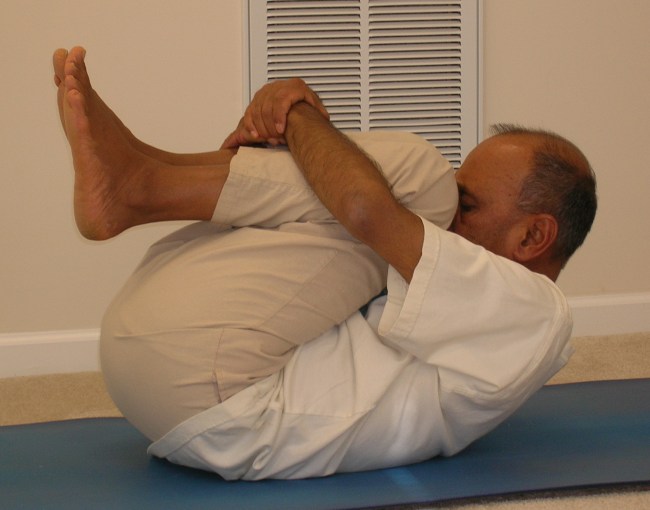
- Exhaling, begin to lift the head up. Again, in a conscious effort to round the spine, try to close the gap between the knees and the forehead
- Inhaling, lower the head down
- Repeat steps 7 and 8 for three more deep breaths
- Finally rest in shavasana
Half Bridge Pose (Setu-bandhasana )
- Lie on your back. Fold the knees and place the feet flat on the floor with the heels close to the buttocks. Keep the feet hip distance apart. Keep the arms alongside the body with the palms facing down.
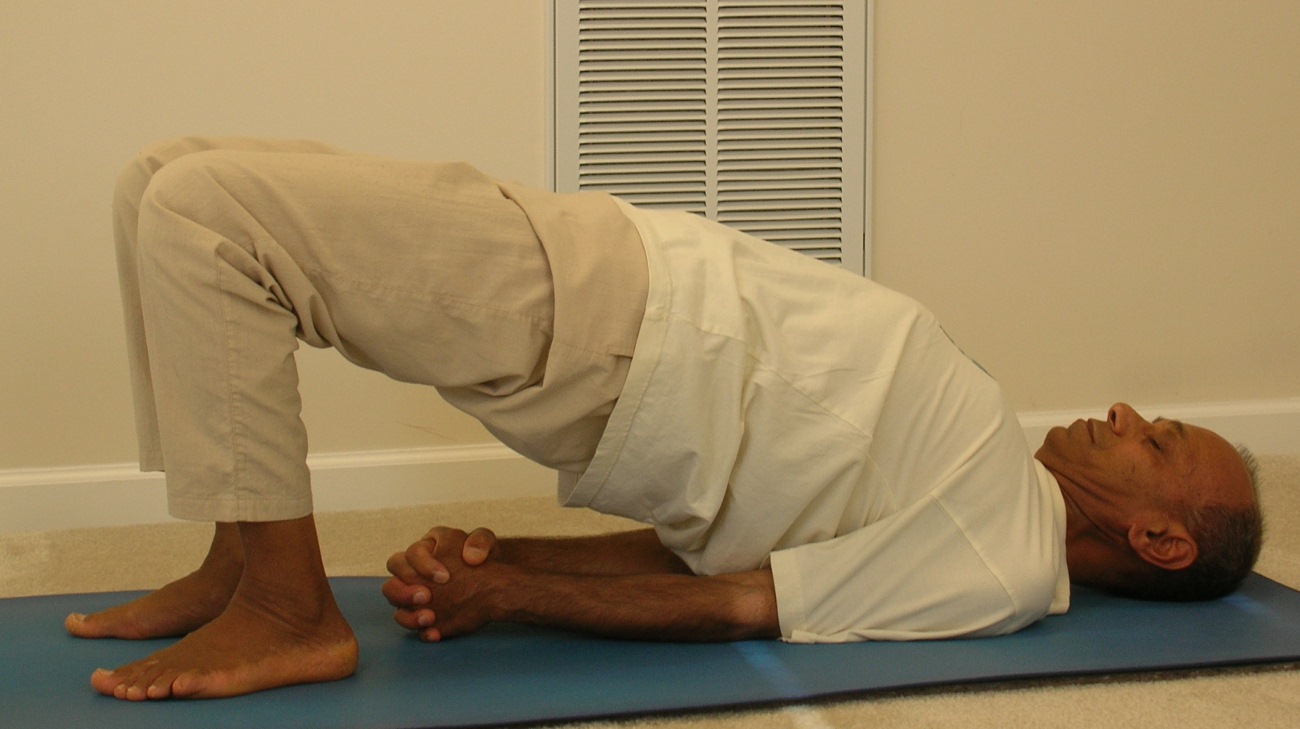
- As you inhale, pressing with the heels, raise the buttocks as high as comfortable. Also, try to roll the shoulder blades back in an effort to lift the chest higher.
- As you exhale, gently lower the buttocks down to the floor
- Repeat steps 2 and 3 for three more deep breaths
- Next time you inhale, raise the buttocks up and hold the position for four deep breaths. In this position, you may try to clasp the hands together under the back, stretch the elbows straight and maintain the effort to lift the buttocks and chest higher
- When you are ready to come out of the pose, exhale and gently lower the buttocks down
- Relax for three breaths. Now spread the feet slightly wider, just enough so you can hold the ankles with the two hands
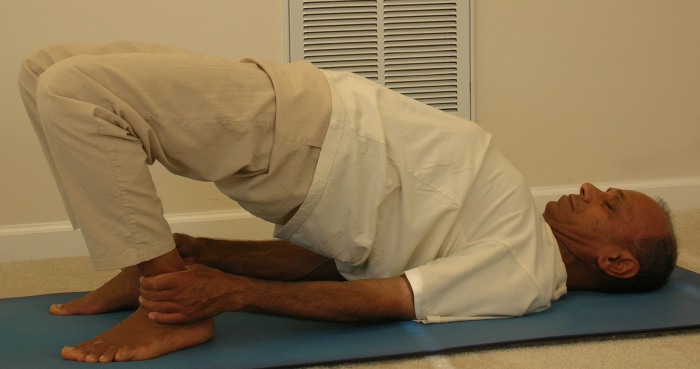
- As you inhale, press down with the heels and begin to raise the buttocks up. Also, try to roll the shoulder blades back in an effort to lift the chest higher.Hold the final position for about ten breaths or as much as is comfortable. Keep a gentle pressure with the heels on the floor.
- When you are ready to come out of the pose, lower the buttocks with an exhalation; relax in shavasana.
In today’s post, I am going to present some simple poses that can help relieve back pain. Back pain, especially pain in the lower back, is perhaps the single most common reason why people seek medical attention. This is also the most common cause why people come to me for help through yoga. On a quick google search, I found several studies that have confirmed that yoga indeed provides a lot of relief to backache sufferers. Despite the well-known benefits that can come with a regular yoga practice, it is strongly advised that in case of severe pain you consult with your doctor before commencing a yoga routine.
What Causes Back Pain?
I will not attempt to go through any details on what can cause back pain. I suggest that you consult a book on the subject or visit one of many websites that deal with the topic in detail (e.g., http://www.backpaindetails.com/pain/). Briefly, these are the possible causes: injury (particularly casued in an auto accident), arthritis, spondylitis, osteoporosis, back pain during pregnancy, poor sitting, standing or walking posture, emotional stress, obesity, herniated disk, diabetes, aging etc.
General Guidelines
Here are some basic guidelines that will help you with the back pain and also prevent any futher injury or aggrevation of the existing condition.
- Keep in mind that the body functions as a unified, integrated whole. A dysfunction in one part of the body can have repercussions in other areas of the body. Back pain is no exception. As stated above, it can be caused by reasons that are internal or external to us. Stress and poor posture are two of the important factors that can easily aggrevate an otherwise mild discomfort in the back. Thus, an integrated approach involving body, breath and mind needs to be used in dealing with and alleviating back pain. I do not recommend an approach that is limited to just a small, fragmented set of asanas only. An integrated approach should include asana, pranayama, relaxation and meditation to heal the body at all levels. Of course, in the routine that you develop for yourself, you should emphasize the asanas that are mentioned here.
- Avoid deep forward-bending poses – standing (Uttanasana) or seated forward bend (Paschimottanasana)
- Avoid deep back-banding poses – wheel pose (chakrasana), upward-facing dog (urdhva-mukka shvanasana), full locust (shalabhasana) and any other pose that creates a deep back bend
- Most twisting poses (lying spinal twist, seated spinal twist etc.), poses that develop a good abdominal strength (e.g., boat pose) etc are highly recommended
Step-by-Step Instructions
Cat and Cow Stretch (Marjarasana)

Cat-and-cow is a popular warmup stretch that helps strengthen and align the spine muscles. In addition to the spine, it also strengthens the abdominal muscles.
- Come on all fours with the spine flat like a table top, hands directly under the shoulders and knees under the hips
- On an inhalation, drop the navel down, lift the head and chin up and move the tailbone upwards, creating an arche in the spine

- On exhalation, do the reverse movement – lift the navel upwards, tuck the chin softly against the chest and also tuck the tailbone in
- Repeat the above moves for 6 to 8 deep breaths and finally bring the spinal back to its neutral position and relax.
Cat-and-Cow Varation
- While inhaling, stretch the left arm out in front and the right leg behind you. Keep the stretched arm and leg straight and lifted as high as comfortable. Keep the head and chin lifted up.

- On exhalation, fold the right knee toward the chest, use the left hand to pull the knee closer to the forehead lowering the chin toward the chest.

- Repeat this move on the other side stretching the right arm and the left leg
- Repeat the two moves three more times

- From the neutral position of the spine, roll the buttocks back and relax in the child pose. In this pose, allow the buttocks to rest on the heels, and keep the arms resting alongside the body. Stay in this position for 4-5 breaths.
Modified Child Pose (Balasana)

- Keeping the buttocks on the heels, slide the hands out in front, keeping the palms on the floor.
- Try to pull the arms and shoulders in front, thus stretching and elongating the spine.
- Stay in the stretched out position for 3-4 breaths and then come back to the original resting position.
Cobra Pose (Bhujangasana):
- From the resting child pose, bring the arms out and start sliding the body forward, finally lowering the knees and the belly to the floor with the palms under the shoulders.

- As you inhale, begin to lift the head, neck and chest as high as comfortable, keeping the navel on the floor. This is the Cobra pose (Bhujangasana)
- Exhaling, lower the chin down to the floor
- Repeat the above moves three more times, maintaining the movement synchronized with the breath
- In the final round, when you lift up into the Cobra Pose, stay up there for about 3 to 4 breaths and then lower the body with an exhalation
- Relax back in the child pose

We will continue our discussion of the headstand (शीर्षासन) and work on two variations in which we use the hands instead of the forearms for support. This pose puts a little extra pressure on the head and the arms as compared to the traditional pose described earlier.
Preparation for the asana
Continue reading »
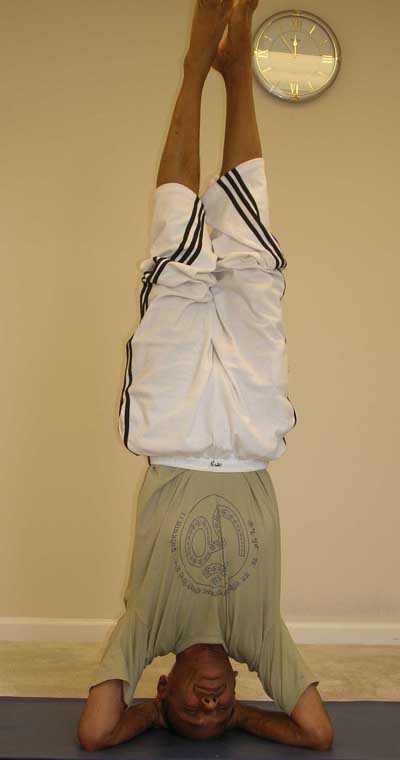
In a previous article, we talked about one of the commonly practiced inverted poses called Sarvangasana (shoulder stand). In today’s article, I am going to discuss another very important inverted pose – Shirshasana – (शीर्षासन) – (headstand). In many yoga texts, shirshasana has been described as "the king of asanas", perhaps due to the many benefits that it provides.
Preparation for the asana
- It is highly advisable that the shirshasana be learned under the guidance of an experienced teacher.
- Beginners should use a wall for support in the early stages. This will help them develop the necessary strength in the neck, shoulders and the head as well as help them develop self-confidence so they can eventually practice it without any support.
Continue reading »
In this article, we will talk about a vinyasa (a flow in which movements are synchronized with breathing) that will help you develop a strong upper body. Regular practice of this routine will build strength in the wrists, arms, shoulders, spine and abdominal muscles. When you want to go beyond the basic yoga poses and start working toward some of the more challenging poses like Mayurasana (Peacock), Bakasana (Crane), all the arm balancing poses etc, a strong upper body becomes a basic requirement. (A photo gallery of some of the commonly practiced asanas is available here).
Continue reading »
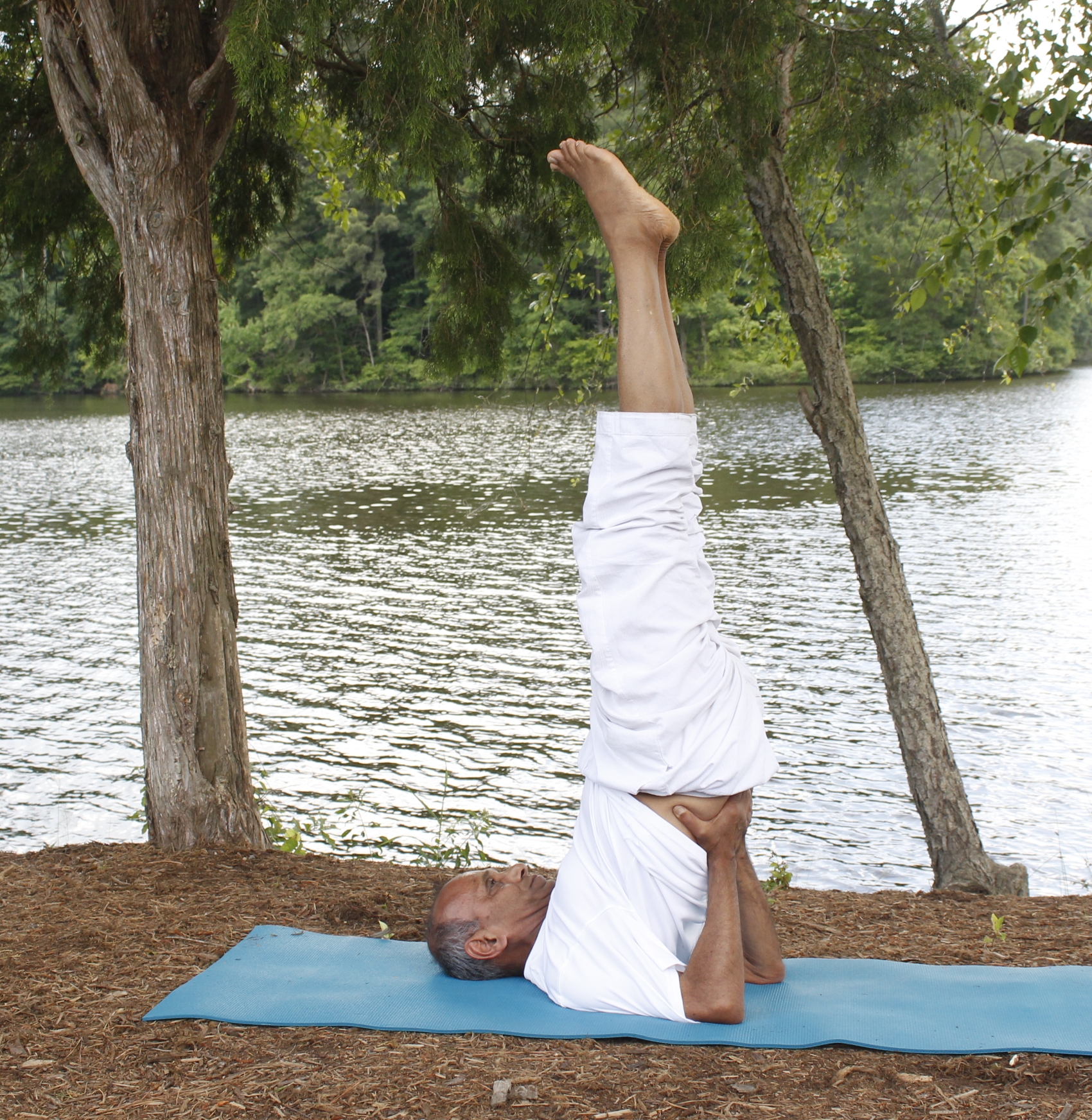
In this article, we will be discussing one of the inverted poses, called Sarvangasana – सर्वाङ्गासन – (commonly translated as the Shoulder Stand or the Supported Shoulder Stand pose). In some yoga texts, this pose is called the "queen of the asanas" (the headstand or the shirShasana is generally referred to as the king of the asanas). The word "sarvangasana" can be broken into two words "sarvanga" and "asana". The word "sarvanga" is a compound word consisting of "sarva" meaning "all" and "anga" meaning "limbs". The word sarvanga implies that this pose when practiced regularly can bring benefits to your entire body. This beneficial effect is mainly achieved by harmonizing the endocrine system, in particular the thyroid and parathyroid glands.
Continue reading »
|
Video DVD
Yoga with Subhash (asana and pranayama)
- Basic asana sequence (~50 min) ($18)
- Pranayama/Meditation (~35 min) ($12)
- Set of above two ($25)
Video recording of special programs offered in the past
(Links to YouTube videos will be provided)
- 21-day yoga immersion - $40
- 7-day hip opening intensive - $20
- 14-day meditation intensive - $30
- 14-day pranayama intensive - $30
- 7-day hamstring/quad intensive - $20
- 14-day Level 2 yoga intensive - $35
Payment options:
- cash, check, Zelle (use subhashmittal@gmail.com) or Venmo (use 9199269717)
- PayPal (go to bottom of page) (add $5 to the fee listed above)
Please contact me if you would like to buy.
|

























Recent Comments